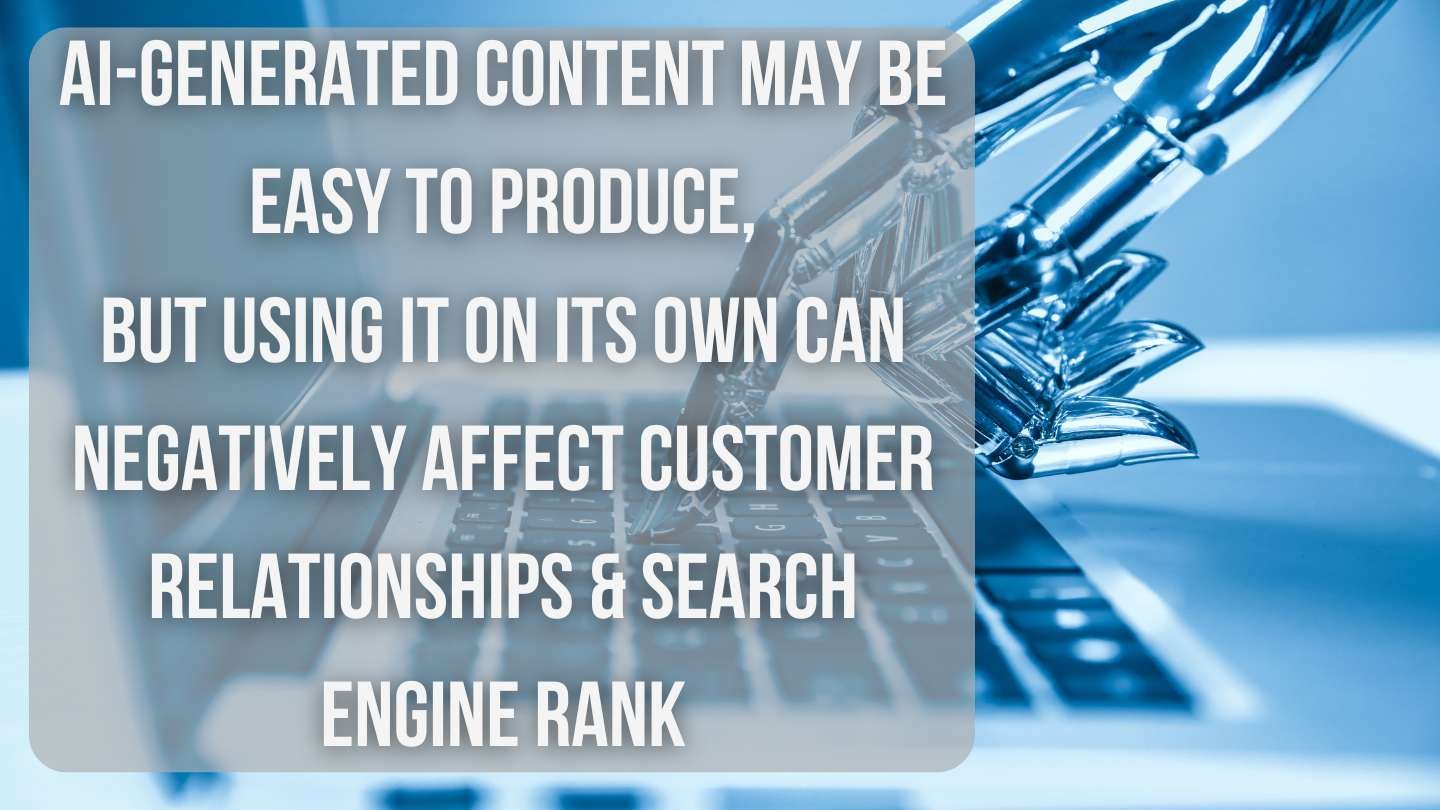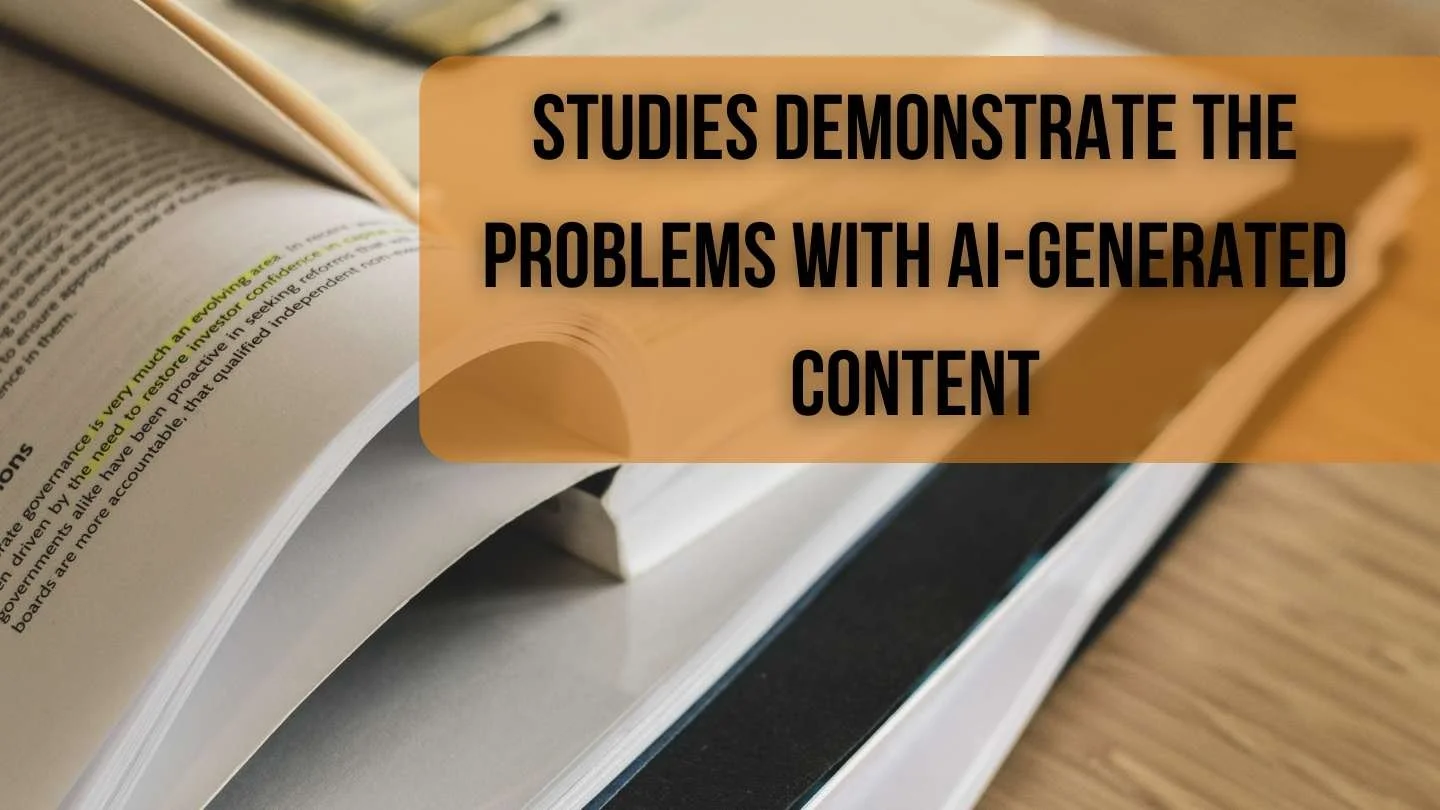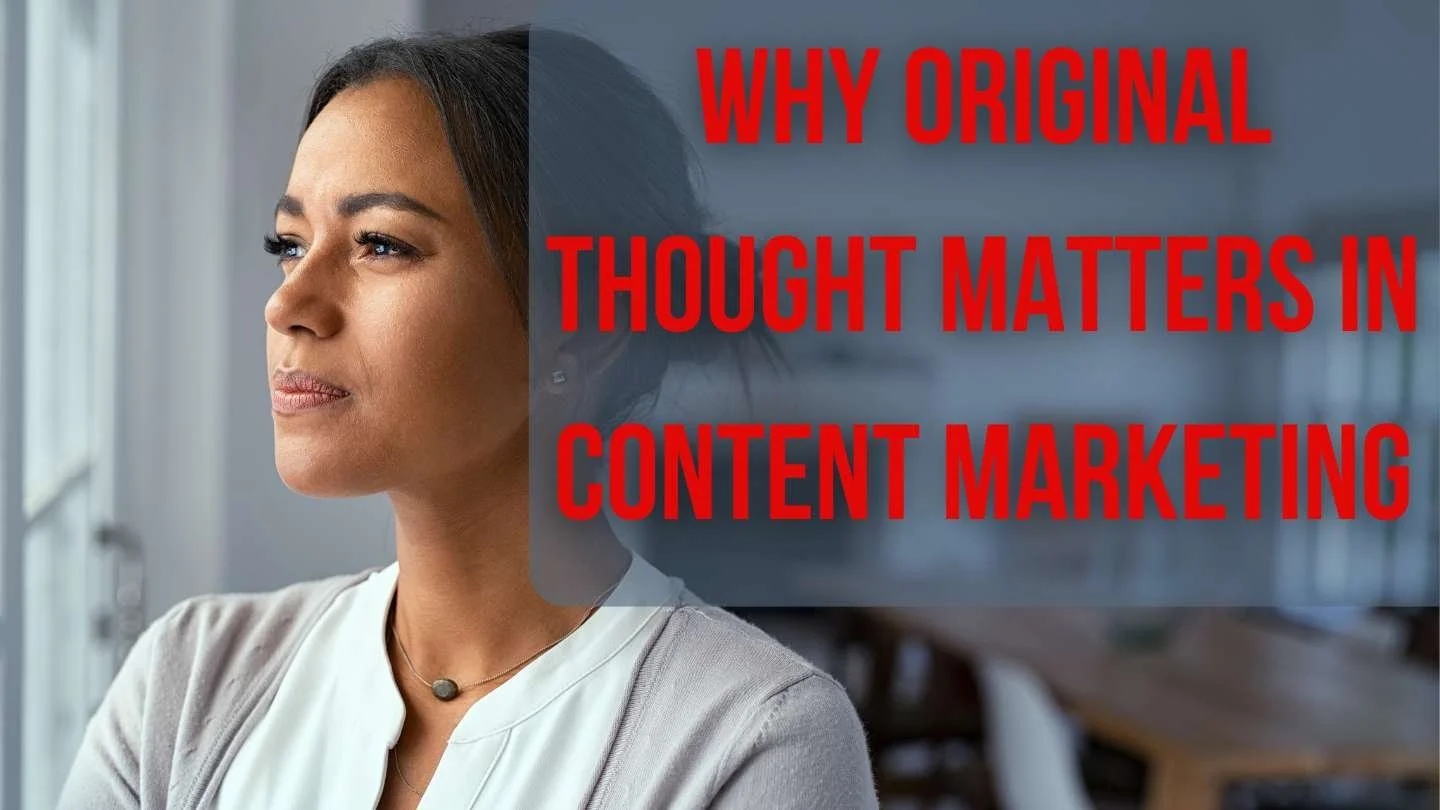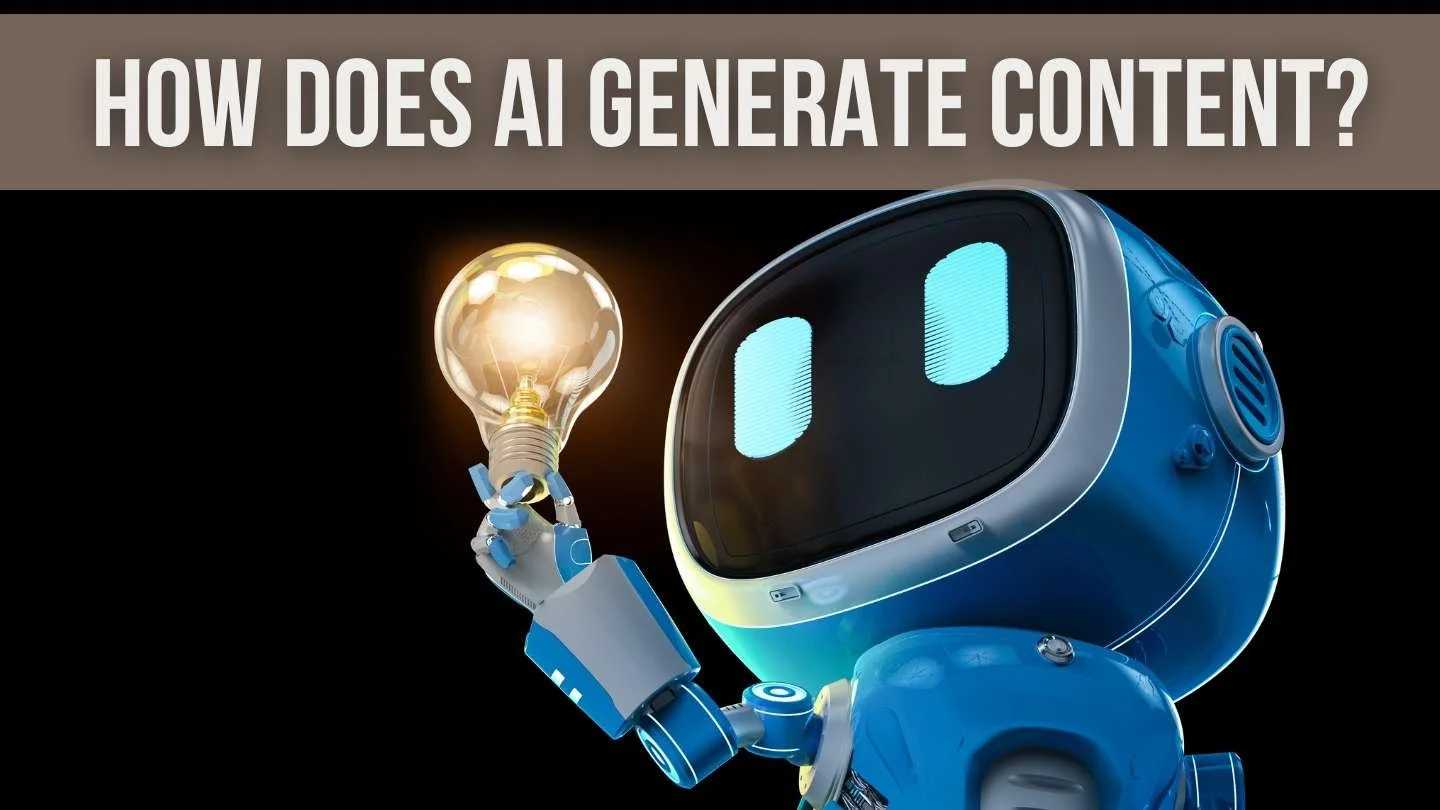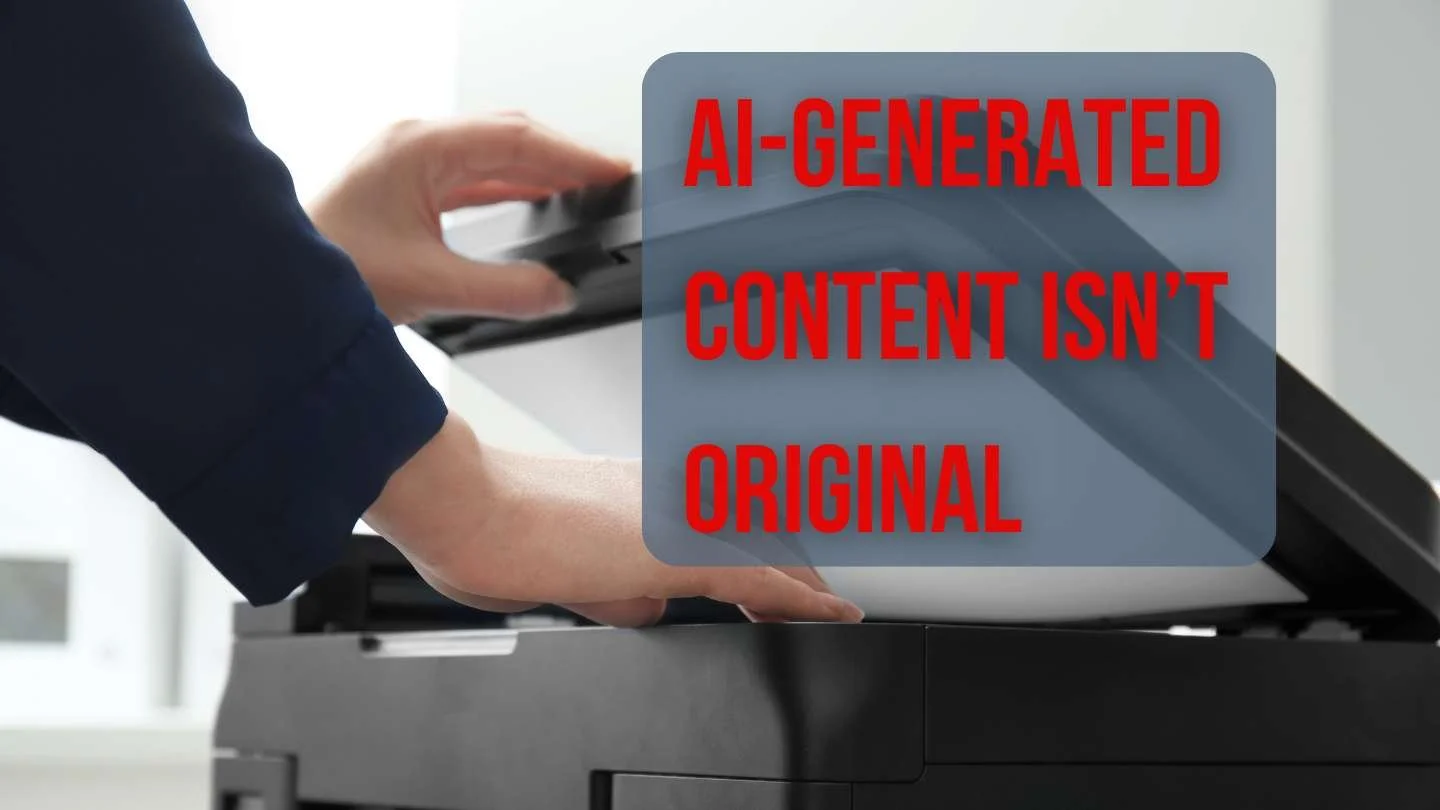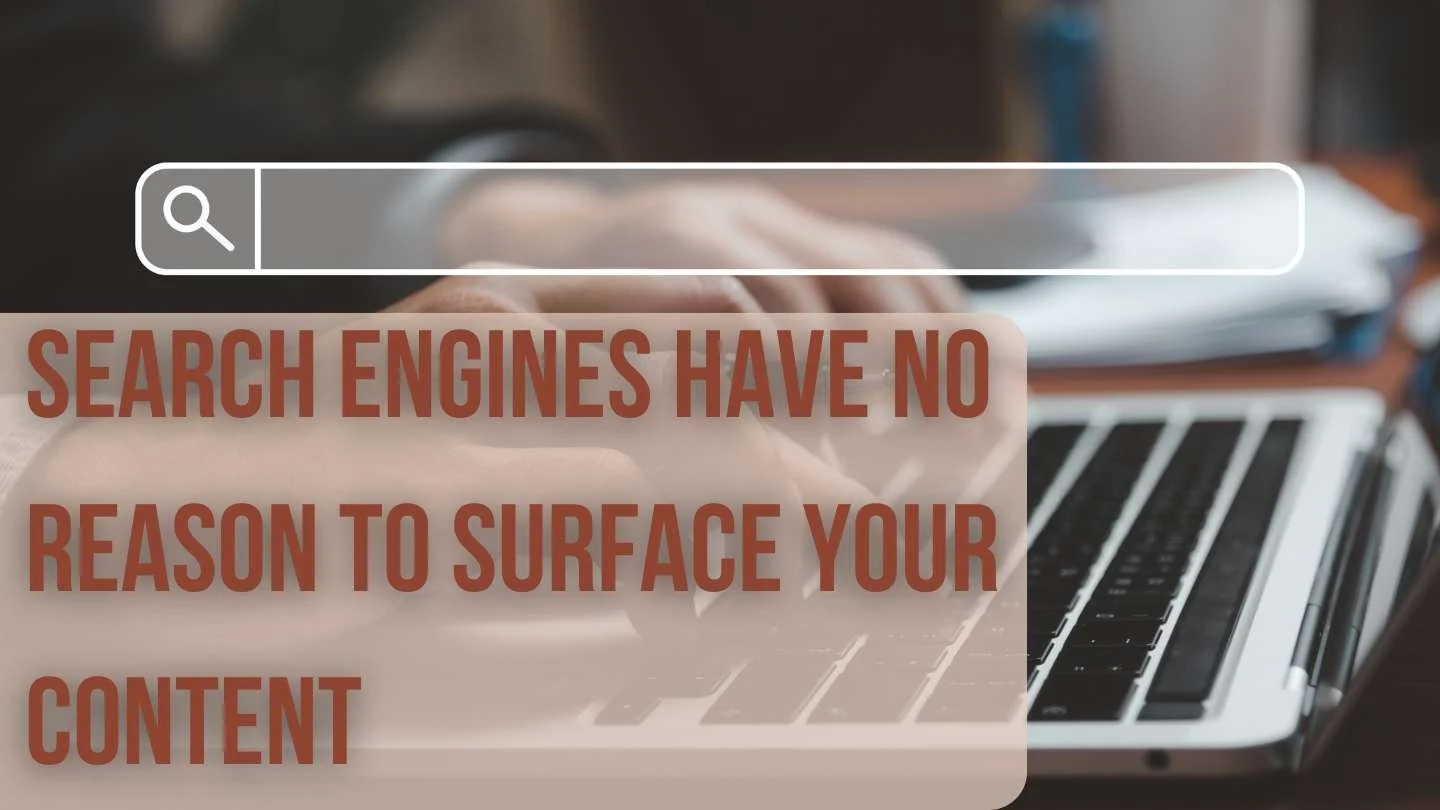Should You Use AI-Generated Content?
Editor’s Note:
The following post coincides with a recent video we posted about the use of AI-generated content. In the video, Charlotte Content Marketing Founder Andrew Rusnak discusses why using AI-generated content may be a bad idea for your customers and for SEO.
He also talks about the concept of originality and helpfulness in content and points out how AI-generated content has no original thought behind it. After all, LLMs like ChatGPT only base their responses on their training data. This means that any content derived from AI will always be some form of regurgitated content that already exists.
If you still choose to use AI to generate content, our advice to overcome these challenges is as follows:
Edit any content that comes from AI
Only use AI as a starting point to create content
Look for opportunities to introduce original thought and concepts into content produced by AI
Think about things from the perspective of your customers as well as search engines
Don’t try to produce content for the sake of ranking in search engine results
AI is a fascinating technology, and while it has its limitations, it can be a powerful tool to create quality, helpful content for your customers. With that said, we never recommend relying solely on AI for content development.
Instead, look for ways to introduce your personal experiences into any content developed by AI. This is where editing content becomes incredibly important as editing allows you to make content your own, crafted for your audience.
Although producing AI-generated content is quick and easy, the content AI produces may not be of good quality.
Over the past year, we’ve seen the strengths and limitations of large language models (LLMs) like OpenAI’s ChatGPT. In the content marketing industry, we’ve had to make some adjustments, and to be honest, we’re going to be continually making adjustments for years to come.
Hell, even the once-thought-to-be indomitable Google has had to do some serious soul-searching over the past year.
ChatGPT and similar LLMs have demonstrated the ability to generate content at lightning speed, and in many cases, the content is convincing at first glance. Now, we’ve seen plenty of drawbacks as well, not the least of which is the hallucination of facts and the repetitive, bland nature of the output.
Studies by major institutions have demonstrated the drawbacks of relying solely on AI-generated content
Studies Demonstrate the Problems With AI-Generated Content
Entities like the American Bar Association have even experimented with AI to test its limitations, and the organization issued a report detailing the potential negative consequences of using AI. The National Institutes of Health conducted a similar study that also found some pitfalls in using AI. Still, if you need quick content that sounds like it makes sense, generative AI is there as an option.
As a content marketing professional, what I haven’t seen much coverage of, and this is a big one, is that LLMs add no original thought to the content they output. This is to say that, because generative AI tech is trained on existing data and basically rearranges it to suit the needs of the prompt, its output will always say something that has already been said.
Original thought demonstrates expertise, experience, authority, and trustworthiness, all of which are important for connecting with customers and search engines
Why Original Thought Matters in Content Marketing
This lack of original thought is important for two reasons:
Content generated by an LLM already exists, so it doesn’t add anything new or valuable to a conversation. There’s no point in duplicating content that can be found elsewhere.
Search engines have no reason to surface your content if it only echoes what has already been said. Search engines look for the best version of coverage for topics. If you’re only re-creating what someone else has already done better, there’s no reason for your content to get ranked higher.
Whenever you produce content, approach the process as a customer to gain valuable perspective. Don’t try to write for search engines. Instead, use content to educate, inform, entertain, and connect with customers
Approach Content From the Perspective of Your Customers
We’re going to take a look at each of these issues separately in detail below, but as you read through this post, I want you to approach things from the perspective of your customers. Try to think about how they see your brand, products, and services, but also try to think about the perception of your brand based on the content you produce.
In this role of the customer, ask yourself the following questions:
Does this content provide value? Does it help me solve a problem?
Does it move me emotionally? Does it mean something to me?
Does it align with the branding of the company producing the content? Is it consistent in tone/voice/imagery?
Does it add anything new to the customer relationship? Does it say something I hadn’t thought of or position something in a new light?
Does it reinforce the authority of the company producing the content? Does it build or establish trust?
These questions may not be ones your customers will ask themselves consciously, but you can bet that your content marketing efforts will have a sub-conscious effect. In fact, that’s a big part of what content marketing does – it builds relationships, and like any good relationship, you have to keep things fresh and exciting to stay afloat.
Your brand’s content is how you connect with customers and build long-term relationships that generate more revenue over time
Content Forms the Basis for Long-Term Customer Relationships
Think about a marriage or long-term friendship. These relationships are ones we value, but after the hundredth time of hearing the same story from a spouse or a friend, you already know the outcome. This can be a bit boring and doesn’t necessarily add value to the relationship.
In your content marketing or SEO efforts, the same applies: What new thing do you have to say that hasn’t been said before? In a marriage or friendship, the stories you tell should always evolve because you’re on a life journey with the other person.
In business, you want to accompany your customers on the buyer journey, and this means evolving with them with fresh, original content that is helpful and adds value and meaning to the relationship.
Generative AI large language models use transformer architectures to semantically link words to find the context for content
How Does AI Generate Content?
Before taking a look at the larger issues here, let’s take a moment to go over how AI generates content. In a nutshell, LLMs are trained on existing data. This could be text data, image data, or other types of data, but it’s this data and information that provides the foundation upon which AI generates responses to prompts.
When you prompt an LLM like ChatGPT, it uses transformer technology to look for semantic relationships between words. This is how these technologies generate context. The output is the best guess of the LLM based on its training data and how words semantically fit together.
Generative AI pulls together pieces of information from existing data and uses probability to generate an output
Generative AI Pieces Together Parts From Existing Content
The same thing happens with AI-generated art. The AI trains on a huge volume of images, many of which are labeled. It “learns” what something looks like, and when prompted to “create” something, it cobbles things together the best that it can (unless you’re looking for hands – it still can’t get those right consistently).
So, anytime you ask AI to produce something, the result will be something that is stored in the training data and is then molded to fit the prompt. Some results are very good, but others are downright ghastly.
AI-generated content cobbles together content from training data, meaning you will never truly get original content from LLMs
AI-Generated Content Isn’t Original
In keeping with the points made above, I want to dive deeper into the fatal flaw of AI-generated content mentioned above: The output isn’t new or original.
Much like Frankenstein’s monster, AI-generated content is content that has been stitched together from a variety of sources. After all, LLM’s aren’t sentient, and they aren’t capable of thought. They are a glorified research assistant that can efficiently do its job.
You Shouldn’t Use Unedited Content Direct From LLMs
Now, this lack of originality may not be a problem if you, the human, use LLM’s with your own original thoughts. This is where most people go wrong with AI-generated content. Instead of coming up with a content strategy on their own, they simply prompt ChatGPT, Gemini, Claude, or another LLM with “Write an article or blog post about XYZ.”
Predictably, this will yield results that contain bits and pieces from existing content. This doesn’t mean that the output equals copied or duplicated content.
LLMs Rearrange Existing Content to Form “New” Content
After all, LLMs rearrange what they pull from their training data. You will get new content; however, that new content will just be a rehashed version of what’s out there. It’s just a reorganizing of existing content.
Instead, what I encourage you to do is think about the specific points you want to convey and why you want to convey them. Then, prompt an LLM to get a more specific result.
You’re still going to run into the issue of unoriginal text, but you’re at least directing the conversation and content. From there, you can edit things to fit your brand and speak to your customers from a human point of view.
You shouldn’t write exclusively for search engines, but your content should be optimized to get found and indexed by search engines for maximum impact
Search Engines Have No Reason to Surface Your Content
The other issue with unoriginal content coming from AI is that search engines have no reason to surface unoriginal or unhelpful content. For example, if you have AI generate an article to place on your brand’s website, you need to satisfy the qualifications put in place by search engines like Google if you want that article indexed and showing higher up in search results for relevant search terms.
Search Engines Can Dicipher Content Context
Search engines these days are incredibly sophisticated, and they use technology similar to AI (and sometimes AI itself) to understand the context of content. Search engine indexes rank content based on a variety of factors, and in the case of Google, you want to send signals that your content contains elements of experience, expertise, authoritativeness, and trustworthiness (EEAT).
I also tell our clients here at Charlotte Content Marketing that the personal appeal in your content must be front and center. We do this by constantly looking for ways to ensure the content we produce for clients not only demonstrates EEAT, but also that it contains human elements that appeal to customers.
Ways You Can Support EEAT in Your Content Marketing Efforts
For example, simply including an author bio and then tacking that onto the content your brand posts can be helpful to people. It tells them who wrote the content and gives credibility to the text.
Our goal here is to represent the content as original, helpful, and coming from a place of experience and expertise. An author bio doesn’t make the content better, but it does improve the reader/customer experience.
Similarly, we encourage that content be written in first person when it makes sense to do so to give a personal account of the topic you’re covering. We never want to lie or mislead an audience by fabricating experiences, but if content is produced related to real-world experiences, we want to highlight that by producing content from the perspective of the expert.
AI isn’t going to be able to deliver the personal touch your customers deserve.
Your Customers Deserve Your Best
Although original content is important from the perspective of gaining traction in search results, I go back to the most important factor in all of this: Your customers. Never approach content marketing with the intention of ranking.
At Charlotte Content Marketing, SEO is one of the services we offer, but moreover, we think about SEO in all of the content our team produces. While SEO is not a central reason for creating content, we want to ensure that the content we produce is helpful to customers and is able to be found by search engines.
The Need to Speak Your Customers’ Language Never Changes
I have been in the content marketing industry since 2010, and the one thing that has not changed in all the years I’ve been doing this is the need to speak to customers in a language they can understand.
Copying and pasting the same, tired evergreen content simply retreads the same topics, providing the same information and answers that your competitors have already spit out.
If you aren’t appealing to your customers on a personal level, you’re doing them a disservice. I like to point out to our clients that their customers deserve better than mindless content.
You want to connect with customers? Give them what they want! They trust your brand (or at least you want them to trust your brand), but you can only gain and maintain this trust by serving as a helpful friend upon whom customers can rely for answers.
Can AI Content Connect With Customers?
So, based on everything I’ve covered here, can AI-generated content connect with customers? I don’t think so, at least not without some heavy editing.
AI-generated content can, however, be a great starting point or guide if you’re trying to find ideas. Just remember that the ideas provided by LLMs will essentially be other people’s ideas. You need to make them your own in order to see real-world success and conversions.
Tips for Editing AI-Generated Content
Editing isn’t everyone’s forte, and it can be a tedious process. The goal with editing AI-generated content is to keep the helpful bits and then add to them. We don’t need to get rid of helpful content just because it came from an LLM, but we do want to expand on this content to add something new and original.
Below are some tips for editing AI-generated content:
Create an outline from the content AI produces to look for topics upon which you can expand
Think about personal stories you can add that relate to the content
Look for concrete examples of real-world interactions you can add to make the content more personal
Try to organize the content so that it flows with your overarching point or theme
AI and Ethical Concerns
Another issue that comes along with AI-generated content and originality is the concern over ethics. We recently published a blog post and video about content marketing and ethics, and if your business serves industries like medical or legal, you especially need to pay attention to these issues.
Unoriginal content from AI may be unhelpful, but in the context of industries like medical or legal, it can be dangerous. AI doesn’t discern right from wrong, legal from illegal, or ethical from unethical. Well, at least not in the sense that humans do.
This means that some LLMs could produce content that is unethical or simply downright wrong. If you publish this content, you assume the responsibility, risk, and liability if someone is injured as a result of the content. This is why it’s vital to have an actual expert review the content.
Contact Charlotte Content Marketing to Get Authentic Content
At Charlotte Content Marketing, we provide content marketing services to business owners who want to build, foster, and further customer relationships. To learn how we can help your brand connect in meaningful, personal ways with customers in Charlotte NC, and beyond, call us today to schedule a no-obligation consultation.
We’d love to learn more about your story! Dial (704) 323-6762, or use our contact form to get in touch with our team on the web.

